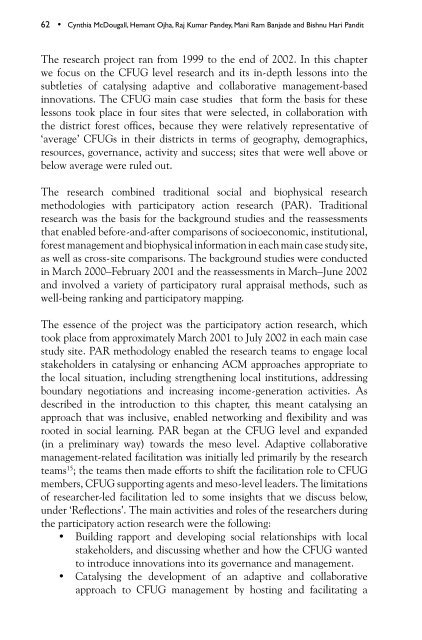Adaptive collaborative management of community forests in Asia ...
Adaptive collaborative management of community forests in Asia ...
Adaptive collaborative management of community forests in Asia ...
Create successful ePaper yourself
Turn your PDF publications into a flip-book with our unique Google optimized e-Paper software.
62 • Cynthia McDougall, Hemant Ojha, Raj Kumar Pandey, Mani Ram Banjade and Bishnu Hari Pandit<br />
The research project ran from 1999 to the end <strong>of</strong> 2002. In this chapter<br />
we focus on the CFUG level research and its <strong>in</strong>-depth lessons <strong>in</strong>to the<br />
subtleties <strong>of</strong> catalys<strong>in</strong>g adaptive and <strong>collaborative</strong> <strong>management</strong>-based<br />
<strong>in</strong>novations. The CFUG ma<strong>in</strong> case studies that form the basis for these<br />
lessons took place <strong>in</strong> four sites that were selected, <strong>in</strong> collaboration with<br />
the district forest <strong>of</strong>fices, because they were relatively representative <strong>of</strong><br />
‘average’ CFUGs <strong>in</strong> their districts <strong>in</strong> terms <strong>of</strong> geography, demographics,<br />
resources, governance, activity and success; sites that were well above or<br />
below average were ruled out.<br />
The research comb<strong>in</strong>ed traditional social and biophysical research<br />
methodologies with participatory action research (PAR). Traditional<br />
research was the basis for the background studies and the reassessments<br />
that enabled before-and-after comparisons <strong>of</strong> socioeconomic, <strong>in</strong>stitutional,<br />
forest <strong>management</strong> and biophysical <strong>in</strong>formation <strong>in</strong> each ma<strong>in</strong> case study site,<br />
as well as cross-site comparisons. The background studies were conducted<br />
<strong>in</strong> March 2000–February 2001 and the reassessments <strong>in</strong> March–June 2002<br />
and <strong>in</strong>volved a variety <strong>of</strong> participatory rural appraisal methods, such as<br />
well-be<strong>in</strong>g rank<strong>in</strong>g and participatory mapp<strong>in</strong>g.<br />
The essence <strong>of</strong> the project was the participatory action research, which<br />
took place from approximately March 2001 to July 2002 <strong>in</strong> each ma<strong>in</strong> case<br />
study site. PAR methodology enabled the research teams to engage local<br />
stakeholders <strong>in</strong> catalys<strong>in</strong>g or enhanc<strong>in</strong>g ACM approaches appropriate to<br />
the local situation, <strong>in</strong>clud<strong>in</strong>g strengthen<strong>in</strong>g local <strong>in</strong>stitutions, address<strong>in</strong>g<br />
boundary negotiations and <strong>in</strong>creas<strong>in</strong>g <strong>in</strong>come-generation activities. As<br />
described <strong>in</strong> the <strong>in</strong>troduction to this chapter, this meant catalys<strong>in</strong>g an<br />
approach that was <strong>in</strong>clusive, enabled network<strong>in</strong>g and flexibility and was<br />
rooted <strong>in</strong> social learn<strong>in</strong>g. PAR began at the CFUG level and expanded<br />
(<strong>in</strong> a prelim<strong>in</strong>ary way) towards the meso level. <strong>Adaptive</strong> <strong>collaborative</strong><br />
<strong>management</strong>-related facilitation was <strong>in</strong>itially led primarily by the research<br />
teams 15 ; the teams then made efforts to shift the facilitation role to CFUG<br />
members, CFUG support<strong>in</strong>g agents and meso-level leaders. The limitations<br />
<strong>of</strong> researcher-led facilitation led to some <strong>in</strong>sights that we discuss below,<br />
under ‘Reflections’. The ma<strong>in</strong> activities and roles <strong>of</strong> the researchers dur<strong>in</strong>g<br />
the participatory action research were the follow<strong>in</strong>g:<br />
• Build<strong>in</strong>g rapport and develop<strong>in</strong>g social relationships with local<br />
stakeholders, and discuss<strong>in</strong>g whether and how the CFUG wanted<br />
to <strong>in</strong>troduce <strong>in</strong>novations <strong>in</strong>to its governance and <strong>management</strong>.<br />
• Catalys<strong>in</strong>g the development <strong>of</strong> an adaptive and <strong>collaborative</strong><br />
approach to CFUG <strong>management</strong> by host<strong>in</strong>g and facilitat<strong>in</strong>g a
















